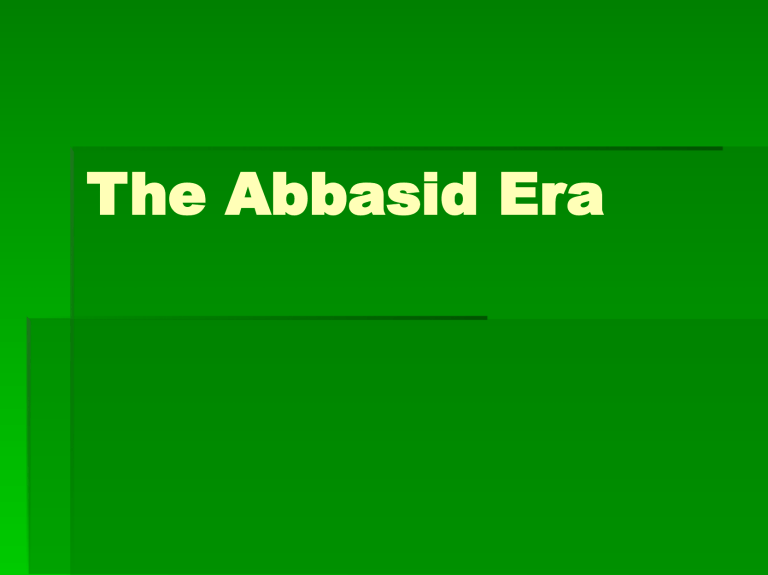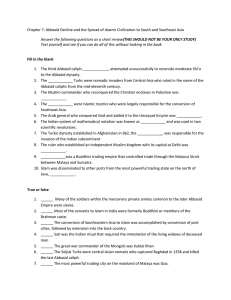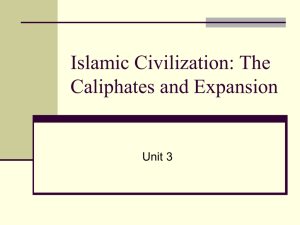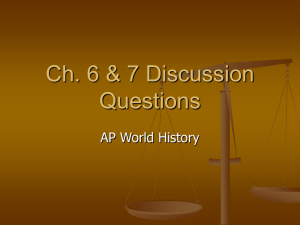The Abbasid Era

The Abbasid Era
From Arab to Islamic Empire:
The Early Abbasid Era
• Abbasids slowly eliminate all enemies, become more righteous about their defense of Sunni
Islam, and less tolerant of Shi’a sects. This leads to the building of a centralized, absolutist imperial order.
• Moved the capital to Baghdad
• Huge and expanded bureaucracy- Symbol of bureaucratization of empire in wazir- chief administrator and head of the caliph’s inner councils
Islamic Conversion and
Mawali Acceptance
• Full integration of new converts, both
Arab and non-Arab
• Mass conversions encouraged o Appeal of Islamic beliefs o o
Muslims exempt from paying head tax
More opportunities for schooling and careers
Persians came to dominate
Town and Country:
Commercial Boom and
Agrarian Expansion
• Rise in growth and status of merchant and landlord classes
• Urban expansion linked to a revival of the Afro-
Eurasian trading network o o o o o
Arab dhows- sailing vessels
Joint ventures with Christians and Jews
Specialized trade in luxury items for the elite
This growth encouraged handicraft production
Unskilled labor left to slaves
First Flowering of Islamic
Learning
• Arabs, from the desert at first, were illiterate and ignorant
• Land they took over was the site of ancient centers of civilization
• Arabs open to influences and very tolerant
• Early Abbasid rule o Focus on mosques o o o
Advances in science and mathematics
“saved” Greek scholarship
Carriers of goods and inventions- eventually brought the Indian number system to Europe, which would play a role in the
Scientific Revolution
Losing Control of the
Dynasty
• By mid-9th century CE Abbasid dynasty had begun to lose control over empire with rebellious governors and new dynasties to challenge them
• Ironically this was a time of creativity and expansion
• From 10th-14th century Muslim warriors, traders, and wandering mystics spread Islam, which would play a huge role in the extension and transformation of the
Afro-Asian world
• Became conduits for exchange of ideas, medicine, inventions, etc.
The Islamic Heartlands in the
Middle and Late Abbasid Eras
• 3rd Abbasid caliph- al-Mahdi (775-785) already signs of division,
Shi’a revolts common, had a life of luxury, failed to fix the problem of succession o Eldest son was poisoned after alMahdi’s death
• Harun al-Rashid (786 – 809) – most famous of the Abbasid caliphs
(only 23 when he ascended the throne) o Luxurious livingevident in Baghdad’s mosques, palacesimmortalized in The Thousand and One Nights o o
Because of his youth very dependent on Persian advisors, which had consequences later in that the royal court became more important than the caliph
Problem of succession after his death- leads to civil war
Sons of al Ma’mun (813-833) (he won the first civil war) armed themselves in anticipation of their fight for successor . The son who won had 4,000 slaves from CAR, which he increased to 70,000. This would be a mistake since they would revolt and kill him and the next 4 caliphs
Imperial Breakdown and
Agrarian Disorder
• Resources drained with constant civil disobedience and the building of extravagant palaces and mosques
• This leads to abandonment of many farming peasant villages and agricultural production in the Tigris-Euphrates basin fell into disrepair
• Increased Shi’a instigation of uprisings
Declining Position of Women in the Family and Society
• Harem was a creation of the Abbasid court
• Growing wealth of the Abbasid elite created a demand for female and male slaves (mostly from regions surrounding the empire like the
Balkans, CAR, Sudanic Africa)
• Slave concubines had more freedom than freeborn wives
• Women’s freedom severely curtailed during this time
Nomadic Incursions and the
Eclipse of Caliphal power
• Caliphs too preoccupied with struggles in the capital to control loss of territory on the outskirts of the empire
• In 945 armies of regional splinter dynasties- Buyids of
Persia- invaded the heartlands and captured Baghdad o o
Buyids took the title of Sultan
Controlled the caliph and the court but couldn’t prevent the disintegration of the empire
1055 Seljuk Turks took over the Buyids
Staunch Sunnispurged remaining Shi’a officials
Got rid of Byzantine threat
The Impact of the
Christian Crusades
• Crusaders determined to capture portions of the Islamic world that made up the Holy Land of biblical times
• 1096-1099 crusader’s assault most deadly- captured holy land and divided it into Christian kingdoms - Jerusalem taken in June 1099
• Europeans mounted eight Crusades and for two centuries had a hold on the Mediterranean
• Salah-ud-Din in last decades of 12th century- strong leaderrecaptured most crusader outposts 1291- end of crusader influence
• Crusades intensified European borrowing from the Muslim world o Swords, building fortifications (castles), recovery of Greek learning, mastered Arabic numbers, demand for rugs o Muslims showed little interest in borrowing from the west
An Age of Learning and
Artistic Refinements
• Expansion of professional classes
• Artists and artisans prospered because of high demand for luxury goods
• Persian replaced Arabic as the primary written language at the
Abbasid court o o o o
Shah- Nama (Book of Kings) by Firdawsi in late 10th century- brilliant work detailing history of Persia
Islamic civilization outstripped others in scientific achievement
Math- sine, cosine, tangent
Chemistry- animal, vegetable, mineral classification
Papermaking, silk-weaving, ceramic firing- from China o Great maps
• Ulama- orthodox religious scholars – increasingly suspicious of non-Muslim ideas
• Al- Ghazali- greatest Islamic theologian – tried to fuse the Greek and Qur’anic traditions
• Sufism- similar to ascetic movement in
Hinduism/Buddhism- Sufis were wandering mystics who sought personal union with Allahhelped continue expansion of Islamic civilization b/c gained following
• Mongols (Chinggis Khan) first raided in the
1220s o 1258 (HuleguKhan’s grandson) takes Baghdad



